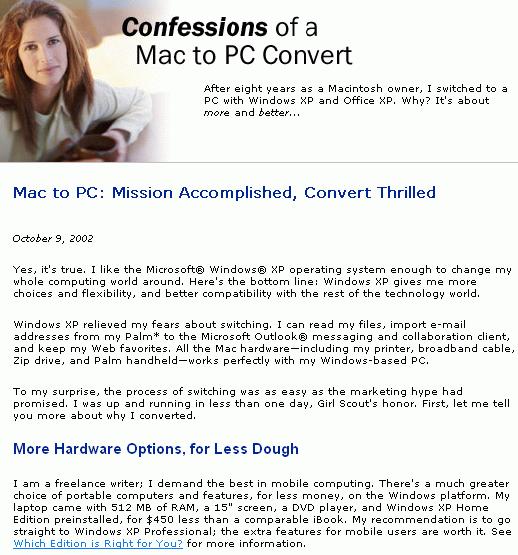HOME
TOPICS
ABOUT ME
Not even a Girl Scout's honor is sacred in the world of Microsoft's ads. The switcher even pledges that what she is saying is truthful: "I was up and running in less than one day, Girl Scout's honor." The ad was yanked as soon as the fakery was discovered.
Al Fasoldt's reviews and commentaries, continuously available online since 1983
Microsoft's fake 'Switch to Windows' ad backfires
Oct. 20, 2002
By Al Fasoldt
Copyright © 2002, Al Fasoldt
Copyright © 2002, The Post-Standard
Apple Computer's "switch" ads are hurting Microsoft's pride. But they aren't nearly as painful as Microsoft's self-inflicted wounds.
Apple has been running ads for many weeks baiting Microsoft over the problems in its much-maligned Windows computer operating system. Apple's clever ads show former Windows users talking about why they switched to the revamped Macintosh. Apple found its "switchers" by going through thousands of unsolicted letters it's received from enthusiastic users. All the "switcher" stories are real, and no identities are faked.
Some of the "switchers" have even developed a cult following, much like soap opera stars or ball players.
This was more than Microsoft could take. Last week Microsoft began running "switch" advertising of its own, featuring a woman who said she switched to a Windows XP computer after using a Macintosh for eight years. "It was easy," she said in the ad.
There was only one problem with Microsoft's ad. It was faked, as sharp observers could see when they looked at the Web page that carried the ad. Partly concealed in the source code for the Web page was information that told who created the document, who edited it and where to find out more information about the origin of the page.
(Most Windows users probably don't know that Microsoft's word processors and Web editors leave telltale personal information partly hidden throughout their documents, something that encourages hackers to steal them.)
Unlike Apple's ads, in which all the "switchers" identify themselves at the end of each ad, Microsoft's ad failed to name its reverse-switcher. And a photo purporting to show the woman who jumped ship from a Mac to a Windows PC was traced to a stock advertising picture. A check of standard ad photos showed that the picture was taken from Getty Images' Photodisk, a CD collection of multipurpose advertising images. The one Microsoft used was royalty-free, meaning the world's wealthiest software company probably got it free or very cheaply. (A sharp-eyed reader even suggests that Microsoft might have simply used a low-res version of the photo, available from Getty, without even goign to the trouble of working with the high-resolution version. It's a fascinating idea. This is a company that supplies software to potentates and poor school kids alike, and the notion that it might be doing things on the cheap makes me wonder what sort of coporate culture it is engendering.)
In the ad, Microsoft's fake reverse-switcher makes a typical-sounding plug for Windows -- "I like the Microsoft Windows XP operating system enough to change my whole computing world around" -- and says that switching to Windows "was as easy as the marketing hype had promised."
But the fake reverse-switcher even pledges that what she is saying is truthful: "I was up and running in less than one day, Girl Scout's honor."
In an effort to rescue its own honor, Microsoft canceled the ad as soon as derisive comments started appearing on Slashdot, the Web-based news service that paraded the faked ad on its main pages. An Associated Press reporter traced the woman's real identity -- Valerie G. Mallinson, an ad agency employee -- by looking at evidence within the document. Her agency is the one that created the ad.
Microsoft said the ad, created by the company's software marketing group, was a mistake in judgment. A spokesman said Microsoft "regrets the action."
Late last week, Chief Executive Officer Steve Ballmer said he'd heard that "some marketing person did something that was not entirely straightforward."
"If that's right, I will certainly castigate the offender," Ballmer said.
Although not referring specifically to the ad flap, Ballmer said the company might have to "weed out" employees who did not live up to Microsoft's code of behavior.
The embarrassing ad wouldn't go away, howvever. It was still visible in Google's storage area, or cache, for a few days, but mysteriously disappeared later. Here's a screen capture of the page that Microsoft hid and Google lost:

A day after it was caught with its scout's honor down, Microsoft pulled another faked ad. In the second ad, a 12-year-old boy is pictured in a home setting. He supposedly says he was able to do his homework better by looking up a Charles Dickens novel in Microsoft's Encarta encyclopedia. But his testimonial isn't convincing, given the typical vocabulary of a 12-year old.
Encarta, the ad quotes him as saying, "helped me to consider some things about the book that I might not have noticed just reading it once, like asking me to look for thematic images and foreshadowing like the red sunset falling on the French palace."
The quote apparently came from an ad agency. The photo accompanying the ad was another stock advertising shot from Getty Images. Slashdot gleefully posted a link to the Getty image of the same boy.
The second ad disappeared immediately after the first ad was withdrawn, following continued ridicule from Slashdot's readers.
Microsoft had no comment on the second ad.
You can read Slashdot's accounts on its site at http://slashdot.org.